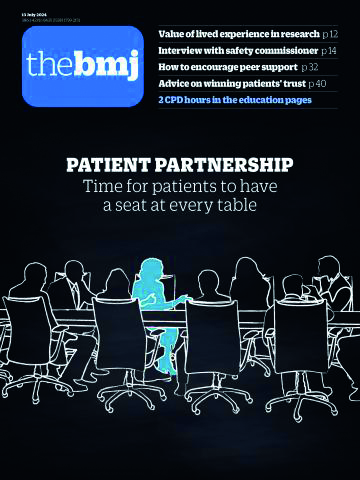
Celebrating a decade of patient and public partnership

We partner with patients and the public across all aspects of our work. Their insights bring a critical dimension to our work and thinking: partnerships with patients, carers, community support networks, and the
public will create better evidence.”Dr Kamran Abbasi
Editor in Chief, The BMJ
Patient involvement in healthcare research is changing the healthcare landscape and building better health systems. Patients are becoming key decision makers in various aspects of healthcare, including research, where funders actively support patient and public involvement.
Ten years since the launch of our patient and public partnership strategy, our successes are largely down to individuals championing the cause and guiding, advising, supporting, and cajoling others on this journey. It was hard—it still is—and we have achieved mixed success.
But we believe that working in partnership with patients and the public brings unique insights into what we publish as well as adding value. We can also point to objective measures of progress and impact.
In July 2024, The BMJ marked ten years of delivering on our patient and public partnership strategy with a special patient led issue. The articles in this issue have been written and curated by patients and the public on topics that matter to them.
While we highlight and celebrate the progress made over the last ten years, we also look to what needs to happen next to ensure patients and the public are part of all aspects of healthcare.

PxP Conference: advancing patient engagement in research
In 2023, the For Patients, By Patients (PxP) conference made history as the first fully patient-led event designed to elevate patient engagement in research. The event was led by an international steering committee of patient partners and supported by the Canadian Institutes of Health Research (CIHR) Institute of Musculoskeletal Health and Arthritis.
Over three days, the virtual conference delved into topics such as boosting skills development, advancing health research innovation, and raising the benchmarks for best practices in patient engagement. It created a global forum for patient partners to learn about topics that are important to them versus topics others felt were important for them to hear about. Multiple evaluations confirm its success in strengthening health research due to more meaningful patient partnerships. Research published in BMJ Open highlights how patient-led initiatives like PxP integrate patient perspectives effectively into research and policy. Other work also notes the positive outcomes of patient-led approaches, affirming the conference’s role in promoting best practices in patient engagement.
The work of the PxP steering committee laid a strong foundation for ongoing patient engagement initiatives and provided a successful model for incorporating patient perspectives into research and policy. BMJ Group’s role in the conference included input from patient editors Amy Price and Sophia Walker as a 2023 steering committee member and a 2024 conference speaker, respectively.

“BMJ Group’s support in amplifying the 2024 conference and expanding our reach is greatly appreciated.”
Dawn Richards
Patient Engagement Specialist, Canadian Institutes of Health Research Institute of Musculoskeletal Health and Arthritis
The impact of patient advocacy on peer review
“”The utility of the peer review template—which I draw from for every peer review—and its anecdotal recognition from its users is an example of how journal editors and authors have appreciated the template.”
Liz Salmi
Communications & Patient Initiatives Director for OpenNotes at Beth Israel Deaconess Medical Center, Boston, Massachusetts

A step-by-step guide to peer review: a template for patients and novice reviewers, co-authored by Liz Salmi and Charlotte Blease, PhD., provides a structured approach to peer review to enhance the involvement of patients and novice researchers in the review process. This guide has been valuable in helping new reviewers understand their roles and the importance of reporting on the impact of research on patients. It has received six formal citations, including one in the monograph Applying Metascientific Principles to Autism Research, which offers practical ideas for academics to improve the quality of their research on the autism spectrum. The guide is also recognised for its practical application beyond academic circles, with informal uses noted by both Ms Salmi and Dr Blease.
As an educator at Uppsala University in Sweden, Dr Blease finds the guide particularly useful for PhD students and early-career researchers. It is an educational tool that helps familiarise them with the peer review process, enhancing their academic training.

“This document is a good example of patient collaboration improving research environments. Such advice must be properly articulated and accessible, as it can significantly enhance research practices.” ”
Dr Charlotte Blease
Associate Professor, Participatory eHealth & Health Data Research Group, Department of Women’s and Children’s Health, Uppsala University; and Digital Psychiatry, Beth Israel Deaconess Medical Center, Harvard Medical School
Both Ms Salmi and Dr Blease believe that the guide inspired the development of similar resources and increased the involvement of patient advocates in peer review, thereby broadening the scope and diversity of reviewers. They add that BMJ Group’s support through the BMJ Patient Advisory Board also significantly contributed to the guide’s visibility and success.





